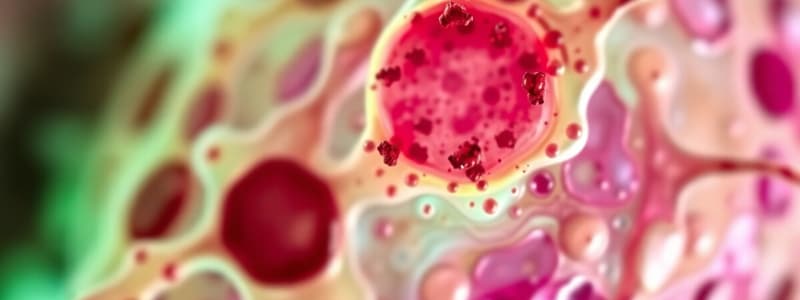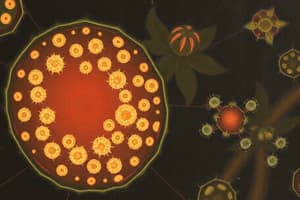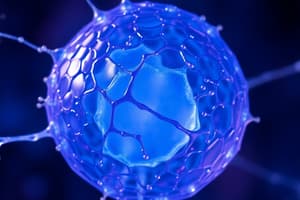Podcast
Questions and Answers
Who is credited with discovering cells by observing cork under a microscope?
Who is credited with discovering cells by observing cork under a microscope?
- Robert Brown
- Purkinje
- Antoine van Leeuwenhoek
- Robert Hooke (correct)
All cells in a multicellular organism have the same function.
All cells in a multicellular organism have the same function.
False (B)
What term did Purkinje coin to refer to the fluid substance of the cell (nucleus + cytoplasm)?
What term did Purkinje coin to refer to the fluid substance of the cell (nucleus + cytoplasm)?
protoplasm
The movement of water molecules through a selectively permeable membrane is called __________.
The movement of water molecules through a selectively permeable membrane is called __________.
Match the following terms with their correct descriptions:
Match the following terms with their correct descriptions:
What is the function of the cell wall in plant cells?
What is the function of the cell wall in plant cells?
The nucleus is surrounded by a single-layered membrane.
The nucleus is surrounded by a single-layered membrane.
What are the functional segments of DNA called?
What are the functional segments of DNA called?
Organisms whose cells lack a nuclear membrane are called __________.
Organisms whose cells lack a nuclear membrane are called __________.
Match the following cell organelles with their primary functions:
Match the following cell organelles with their primary functions:
What is the main function of ribosomes?
What is the main function of ribosomes?
Plastids are present in both animal and plant cells.
Plastids are present in both animal and plant cells.
What term is used to describe the shrinkage or contraction of the protoplasm away from the cell wall due to water loss?
What term is used to describe the shrinkage or contraction of the protoplasm away from the cell wall due to water loss?
The process by which cells engulf food and other materials from their external environment is called __________.
The process by which cells engulf food and other materials from their external environment is called __________.
Match the following terms related to plastids with their correct functions:
Match the following terms related to plastids with their correct functions:
Which cell organelle is known as the 'suicide bag' of the cell?
Which cell organelle is known as the 'suicide bag' of the cell?
Mitosis results in four new cells with half the number of chromosomes as the parent cell.
Mitosis results in four new cells with half the number of chromosomes as the parent cell.
What is the structural and functional unit of life?
What is the structural and functional unit of life?
The central vacuole in plant cells provides __________ and __________ to the cell.
The central vacuole in plant cells provides __________ and __________ to the cell.
Which process is responsible for growth and repair of tissues in organisms?
Which process is responsible for growth and repair of tissues in organisms?
Flashcards
Unicellular Organism
Unicellular Organism
An organism consisting of only one cell
Multicellular Organism
Multicellular Organism
An organism consisting of many cells
Plasma Membrane
Plasma Membrane
The outermost covering of a cell separating contents from the environment.
Protoplasm
Protoplasm
Signup and view all the flashcards
Selectively Permeable Membrane
Selectively Permeable Membrane
Signup and view all the flashcards
Diffusion
Diffusion
Signup and view all the flashcards
Osmosis
Osmosis
Signup and view all the flashcards
Hypotonic Solution
Hypotonic Solution
Signup and view all the flashcards
Isotonic Solution
Isotonic Solution
Signup and view all the flashcards
Hypertonic Solution
Hypertonic Solution
Signup and view all the flashcards
Endocytosis
Endocytosis
Signup and view all the flashcards
Cell Wall
Cell Wall
Signup and view all the flashcards
Plasmolysis
Plasmolysis
Signup and view all the flashcards
Nuclear Membrane
Nuclear Membrane
Signup and view all the flashcards
Chromosomes
Chromosomes
Signup and view all the flashcards
Chromatin
Chromatin
Signup and view all the flashcards
Genes
Genes
Signup and view all the flashcards
Nucleoid
Nucleoid
Signup and view all the flashcards
Prokaryotes
Prokaryotes
Signup and view all the flashcards
Eukaryotes
Eukaryotes
Signup and view all the flashcards
Study Notes
- Robert Hooke discovered that cork resembled a honeycomb structure with little compartments by observing a thin slice of cork with a self-designed microscope.
- Hooke called the compartments cells, meaning "little rooms" in Latin.
- Cork comes from tree bark.
Living Organisms
- Onion bulbs of different sizes have similar cells visible under a microscope.
- Cells are the basic building units of the onion bulb.
- All organisms consist of cells.
- Some organisms are single cells acting independently.
History of Cell Biology (Cytology)
- Robert Hooke (1665) is considered the father of cytology (cell biology)
- Antonie van Leeuwenhoek with an improved microscope discovered free-living cells in pond water
- Leeuwenhoek is considered the father of microbiology.
- Robert Brown discovered the nucleus in the cell.
- Purkinje coined the term 'protoplasm' (nucleus + cytoplasm)
- Schleiden (botanist) and Schwann (zoologist) proposed cell theory: plants and animals are composed of cells, and the cell is the basic unit of life.
- Rudolf Virchow added all cells arise from pre-existing cells to the cell theory
- A single cell can form a whole organism like Amoeba, Chlamydomonas, Paramecium, and bacteria.
Unicellular and Multicellular Organisms
- Organisms made of single cells are unicellular (uni = single)
- Multicellular organisms (multi = many) consist of many cells grouped together to perform different functions; examples include fungi (except yeast), plants, and animals.
- Every multicellular organism originates from a single cell.
- Cells divide to produce cells of the same kind.
Shape & Size of Cells
- Cell shape and size correlate with their specific functions.
- Amoeba cells have changing shapes.
- Some cells have fixed and peculiar shapes, like nerve cells.
- Each living cell can perform some basic functions.
- Multicellular organisms, like humans, exhibit a division of labour.
- Division of labour is seen within a cell.
- Cells contain specific components known as cell organelles.
- Each organelle performs a specific function.
- Cell organelles enable a cell to live and perform its functions.
- Cell organelles make up the basic unit called the cell.
- All cells share the same organelles.
Cell Composition
- Every cell contains plasma membrane, nucleus, and cytoplasm.
- All activities and interactions of the cell are possible.
Plasma Membrane
- Plasma membrane (cell membrane) is the outermost cell covering that separates the cell's contents from its external environment.
- Components of the cell bound by the plasma membrane is protoplasm.
- It allows entry and exit of some materials.
- It prevents some materials from moving.
- The cell membrane is selectively permeable.
- Substances like carbon dioxide and oxygen move across the cell membrane by diffusion.
- CO2 diffuses across the plasma membrane because CO2 concentration is high inside the cell and low outside.
- O2 enters the cell when the O2 concentration inside the cell decreases.
- Diffusion plays a role in gaseous exchange between cells.
- Water also obeys the law of diffusion.
- The movement of water through a selectively permeable membrane is osmosis.
- The movement of water across the plasma membrane is affected by substances dissolved in water.
- Osmosis is water passage from a high to low concentration through a selectively permeable membrane until equilibrium.
Solutions and their tonicity
- A hypotonic solution surrounding a cell has a high water concentration, so the cell gains water by endosmosis and swells up.
- An isotonic solution has the same water concentration as the cell, resulting in no net water movement, and the cell maintains its size.
- A hypertonic solution has a lower water concentration than the cell, causing the cell to lose water by exosmosis and shrink.
- Unicellular freshwater organisms and most plant cells gain water through osmosis.
- Absorption of water by plant roots is an example of osmosis.
- Diffusion facilitates exchange of gases and water in a cell.
- The cell obtains nutrition from its environment.
- Different molecules move in and out of cells through active transport (requires energy).
- The plasma membrane is flexible and consists of lipids and proteins.
- The structure of the plasma membrane is visible via electron microscope.
- Cell’s flexibility enables it to engulf food through endocytosis (phagocytosis for Amoeba).
Cell Wall
- Plant cells have a rigid outer covering called the cell wall, located outside the plasma membrane
- The cell wall is non-living.
- Living components inside the cell wall are protoplast.
- Plant cell walls are mainly made of cellulose, which provides the structural strength to plants.
- Plasmolysis is when a plant cell loses water through osmosis causing contents to shrink, away from the cell wall.
- Only living cells can absorb water by osmosis.
- Cell walls allow plant cells, fungi, and bacteria to withstand very dilute (hypotonic) external media without bursting.
- Cells in dilute media take up water, building up pressure against the cell wall.
- Cell walls counteract the pressure from the swollen cell.
- The surrounding medium changes the cell walls of plants more than it does with animal cells.
Nucleus
- Iodine, safranin, or methylene blue solutions stain cells.
- Nucleus is a dark, oval or spherical structure in the center of each cell
- A double-layered nuclear membrane covers the nucleus.
- A nuclear membrane contains pores allowing nucleoplasm to cytoplasm transfer.
- Nucleus contains chromosomes, visible as rod-shaped structures when the cell divides.
- Chromosomes contain inheritable information from parents in the form of DNA molecules.
- Chromosomes consist of DNA and protein.
- DNA molecules contain information for constructing and organizing cells.
- Functional segments of DNA are genes.
- A non-dividing cell contains DNA as chromatin material, which appear as threadlike structures.
- Chromatin material organizes into chromosomes when the cell divides.
- Nucleus plays a role in cellular reproduction.
- The cell depends on the environment and the nucleus to decide to develop and how it will develop as the organism matures
- Bacteria lack a well-defined nuclear region due to the absence of a nuclear membrane.
- A nucleoid is the undefined nuclear region that contains only nucleic acids.
Prokaryotes vs Eukaryotes
- Prokaryotes lack nuclear membrane.
- Eukaryotes have nuclear membrane.
- Prokaryotes also lack most cytoplasmic organelles.
- The functions of prokaryotic organelles are performed by poorly formed parts of the cytoplasm.
- Chlorophyll in photosynthetic prokaryotic bacteria associates with membranous vesicles but not with plastids like in eukaryotic cells.
Cytoplasm
- Cytoplasm is a large region of the cell enclosed by the cell membrane.
- Cytoplasm takes up minimal stains under observation
- Cytoplasm contains fluid and special organelles.
- Each organelle specializes in functions for the cell
- Cell organelles are enclosed by membranes in eukaryotes
- Prokaryotes do not have membrane-bound organelles.
- Eukaryotes have membrane-enclosed organelles as well as a nuclear membrane.
- Viruses do not show characteristics of life until they multiply inside a living host.
Sizes of Cells
- Prokaryotic cells are small with undefined nuclear regions whereas Eukaryotic cells are large and have double layered nuclear membrane
- In a prokaryote, the chromatin condenses to a single chromosome, whereas eukaryotes have multiple.
- No membrane-bound organelles in prokaryotes. Membrane-bound organelles in eukaryotes
Cell Organelles
- Cells use membrane-bound little structures called cell organelles to support various complicated activities
- Some chemicals separate with membrane-bound little structures
Endoplasmic Reticulum
- The endoplasmic reticulum (ER) is a large network of membrane-bound tubes and sheets.
- ER looks like either tubules or vesicles (round or oblong bags).
- The ER membrane structurally resembles the plasma membrane.
Two Types of Endoplasmic Reticulum
- Rough endoplasmic reticulum (RER) appears rough as it is attached to ribosomes, which are the sites of protein manufacture.
- The ribosomes, which produce RER are present in every active cell
- Ribosomes’ manufactured proteins are transported to various places inside the cell via ER
- Smooth endoplasmic reticulum (SER) helps in the manufacture of lipids for cell function.
- Proteins and lipids help in membrane biogenesis and function as enzymes and hormones
- Endoplasmic Reticulum (ER) varies in appearance in different cells, but forms a network system.
- ER transports materials between cytoplasm regions between cytoplasm to nucleus.
- ER serves as a framework for biochemical activities.
- In vertebrates, SER in the liver cells detoxifies poisons and drugs.
Golgi Apparatus
- Camillo Golgi first described the Golgi apparatus.
- Golgi body consists of flattened sacs of membrane-bound vesicles arranged parallel called cisterns
- Golgi membranes connect with the ER membranes.
- ER synthesizes, stores, modifies, packages, and dispatches materials inside and outside the cell with the Golgi apparatuses
- In some cases, complex sugars are produced y the Golgi apparatus from simple sugars.
- Golgi apparatus is responsible for the formation of lysosomes
Lysosomes
- Lysosomes are membrane-bound sacs with digestive enzymes made by RER and modified by Golgi bodies.
- They are the cell’s waste disposal system
- Lysosomes keep cells clean by digesting foreign material and worn out organelles.
- During cell damage lysosomes may burst and digest the cell.
- Lysosomes are known as the 'suicide bags' of the cell.
Mitochondria
- Mitochondria are referred to as "powerhouses of the cell".
- Double membrane coverings.
- The outer membrane is porous whereas the inner membrane is deeply folded.
- ATP is created when folds increase surface area for ATP generating chemical reactions.
- The energy required for life’s activities is released by mitochondria in the form of ATP (Adenosine tri-phosphate) molecules
- ATP functions as the energy currency of the cell.
- The body uses ATP to make new chemical compounds and work mechanically.
- Mitochondria have their own DNA and ribosomes.
- Mitochondria can form their own proteins.
Plastids
- Plastids are found in plant cells
- Plastids contain DNA and ribosomes
Types of Plastids
- Chromoplasts (colored plastids) containing chlorophyll are named chloroplasts, they are important for photosynthesis and yellow/orange pigments.
- Internal organization of Chloroplast consists of membrane layers embedded in stroma
- Leucoplasts (white or colourless plastids) store materials such as starch, oils and protein granules.
Vacuoles
- Vacuoles store solid or liquid contents.
- Vacuoles are small in animal cells and large in plant cells (occupying 50-90% of the cell volume)
- Vacuoles in plants store cell sap in cell sap which provides turgidity and rigidity.
- Vacuoles store substances like amino acids, sugars, various organic acids, and some proteins etc.
- Amoeba has a food vacuole with consumed food items.
- Unicellular organisms have contractile vacuoles for expelling excess water and some wastes.
- Membrane, organelles, structure, and function are due to the organization.
- The structural organization helps to perform functions like respiration, obtaining nutrition, and clearing of waste material, or forming new proteins.
- The cell is the fundamental structural and functional unit of life.
Cell Division
- Cell division creates new cells to form organisms, replace old cells and create gametes
- The process is known is cell division
- The process is called cell division
- Mitosis: the process of cell division for growth and repair, a mother cell divides and forms two clones of identical cells, each daughter cell has a same clone for chromosomes.
- Meiosis: the cells divide by two consecutive divisions where reproductive organs of animals and plants form gametes by fertilisation to give rise to offspring, 4 new cells created each with half the number of chromosomes of the mother cells.
Studying That Suits You
Use AI to generate personalized quizzes and flashcards to suit your learning preferences.




